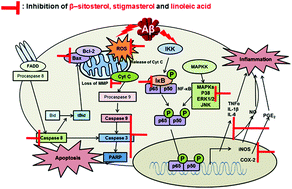当前位置:
X-MOL 学术
›
Food Funct.
›
论文详情
Our official English website, www.x-mol.net, welcomes your feedback! (Note: you will need to create a separate account there.)
Major compounds of red ginseng oil attenuate Aβ25–35-induced neuronal apoptosis and inflammation by modulating MAPK/NF-κB pathway
Food & Function ( IF 6.1 ) Pub Date : 2018-07-10 , DOI: 10.1039/c8fo00795k Seonah Lee 1, 2, 3, 4 , Kumju Youn 1, 2, 3, 4 , Mira Jun 1, 2, 3, 4
Food & Function ( IF 6.1 ) Pub Date : 2018-07-10 , DOI: 10.1039/c8fo00795k Seonah Lee 1, 2, 3, 4 , Kumju Youn 1, 2, 3, 4 , Mira Jun 1, 2, 3, 4
Affiliation

|
β-Amyloid (Aβ)-induced neuronal toxicity in Alzheimer's disease (AD) is associated with complex mechanisms. Thus, a multi-target approach might be suitable for AD treatment. Following our previous study on the neuroprotective effects of red ginseng oil extract, its major compounds, including linoleic acid (LA), β-sitosterol (BS), and stigmasterol (SS), were examined to elucidate the mechanism of anti-apoptosis and anti-inflammation in Aβ25–35-stimulated PC12 cells. The results showed that the three compounds mitigated Aβ25–35 toxicity by regulating oxidative stress, apoptotic responses, and pro-inflammatory mediators. LA and SS strongly regulated intrinsic apoptosis markers, such as mitochondrial membrane potential, intracellular Ca2+, Bax/Bcl-2 ratio, and caspases-9, -3, and -8. However, BS blocked only the intrinsic apoptotic pathway, particularly by suppressing Ca2+ accumulation. Furthermore, all three compounds downregulated iNOS and phospho-nuclear factor-κB, but only LA and SS inhibited the expression of cyclooxygenase-2 and phospho-IκB. In assays to evaluate MAPK expression for confirming upstream signal pathways, BS decreased the phosphorylation of p38 and ERK, but not JNK, while SS markedly decreased the phosphorylation of all three MAPKs, and LA clearly decreased the phosphorylation of ERK and JNK, but not p38. These results indicate that LA, BS, and SS act as neuroprotectives against Aβ25–35-induced injury by distinct molecular mechanisms, indicating their preventive and/or therapeutic potential to treat AD.
中文翻译:

红参油中的主要化合物通过调节MAPK /NF-κB途径减轻Aβ25-35诱导的神经元凋亡和炎症。
β-淀粉样蛋白(Aβ)诱导的阿尔茨海默氏病(AD)的神经元毒性与复杂的机制有关。因此,多目标方法可能适用于AD治疗。在我们先前对红参油提取物的神经保护作用进行研究之后,研究了其主要化合物,包括亚油酸(LA),β-谷甾醇(BS)和豆甾醇(SS),以阐明抗凋亡和抗凋亡的机制。 -inflammation在Aβ 25-35刺激的PC12细胞。结果表明,这三种化合物通过调节氧化应激,细胞凋亡反应和促炎介质,减轻了Aβ25-35的毒性。LA和SS强烈调节内在凋亡标记,例如线粒体膜电位,细胞内Ca 2+,Bax / Bcl-2比率以及caspases-9,-3和-8。但是,BS仅阻断内在的凋亡途径,特别是通过抑制Ca 2+的积累。此外,这三种化合物均下调了iNOS和磷酸核因子-κB,但只有LA和SS抑制了环氧合酶2和磷酸化-IκB的表达。在评估MAPK表达以确认上游信号通路的测定中,BS降低了p38和ERK的磷酸化,但未降低JNK,而SS显着降低了所有三个MAPK的磷酸化,而LA明显降低了ERK和JNK的磷酸化,但未降低p38。 。这些结果表明,LA,BS和SS作为对抗Aβ神经保护剂25-35通过不同的分子机制引起的损伤,表明它们具有预防和/或治疗AD的潜力。
更新日期:2018-08-15
中文翻译:

红参油中的主要化合物通过调节MAPK /NF-κB途径减轻Aβ25-35诱导的神经元凋亡和炎症。
β-淀粉样蛋白(Aβ)诱导的阿尔茨海默氏病(AD)的神经元毒性与复杂的机制有关。因此,多目标方法可能适用于AD治疗。在我们先前对红参油提取物的神经保护作用进行研究之后,研究了其主要化合物,包括亚油酸(LA),β-谷甾醇(BS)和豆甾醇(SS),以阐明抗凋亡和抗凋亡的机制。 -inflammation在Aβ 25-35刺激的PC12细胞。结果表明,这三种化合物通过调节氧化应激,细胞凋亡反应和促炎介质,减轻了Aβ25-35的毒性。LA和SS强烈调节内在凋亡标记,例如线粒体膜电位,细胞内Ca 2+,Bax / Bcl-2比率以及caspases-9,-3和-8。但是,BS仅阻断内在的凋亡途径,特别是通过抑制Ca 2+的积累。此外,这三种化合物均下调了iNOS和磷酸核因子-κB,但只有LA和SS抑制了环氧合酶2和磷酸化-IκB的表达。在评估MAPK表达以确认上游信号通路的测定中,BS降低了p38和ERK的磷酸化,但未降低JNK,而SS显着降低了所有三个MAPK的磷酸化,而LA明显降低了ERK和JNK的磷酸化,但未降低p38。 。这些结果表明,LA,BS和SS作为对抗Aβ神经保护剂25-35通过不同的分子机制引起的损伤,表明它们具有预防和/或治疗AD的潜力。


























 京公网安备 11010802027423号
京公网安备 11010802027423号